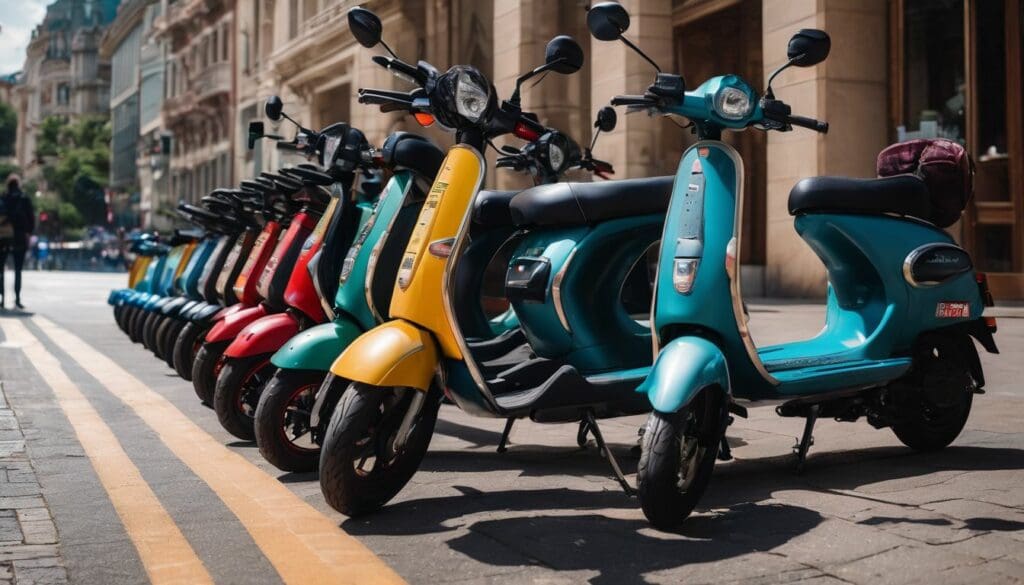Are you fed up with the endless tailbacks every time you nip out for a quick shop? We completely understand, because we’ve been right there in that sluggish queue with you. But hold on, there’s something rather exciting zipping through our streets.
With over half a billion journeys already chalked up by bikeshare and e-bike enthusiasts, micromobility is the nifty term reshaping how we scoot around our cities. Our blog takes a deep dive into this fresh mode of transport – revealing just how these dinky two-wheelers could smooth out your urban jaunts and add a splash of green to boot.
So why not hop on board and see where it takes you?.
Key Takeaways
- Micromobility, including electric scooters and e – bikes, is becoming a vital part of urban transport networks, with over half a billion rides already taken in the U.S.
- E – scooters and shared bicycles help reduce car usage in cities, leading to less congestion, fewer parking problems, improved air quality and lower carbon emissions.
- The popularity of micromobility has led to controversies such as safety concerns and debates about infrastructure needs, highlighting the necessity for effective policies.
- A diverse range of micromobility options like e-scooters and e-bikes are being integrated into city landscapes worldwide, promoting sustainable transportation choices for short distances.
- Shared micro mobility devices are expected to continue growing in number and become even more integrated into existing urban transportation systems globally.
What is Micromobility?
Micromobility refers to the use of small, lightweight vehicles for short-distance travel within urban areas. These include electric scooters, e-bikes, and shared bicycles. The rise of micromobility offers a range of benefits including reducing congestion, improving air quality, and providing convenient transportation options for city dwellers.
Definition
Micromobility refers to small, lightweight vehicles designed for individual use over short distances. Think of e-scooters, electric bikes, and pedal bikes that you can rent across the city; these are all part of this growing phenomenon.
We often see them zipping by on pavements or neatly lined up at charging stations. They’re perfect for the final leg of a journey—what we call “last-mile” transportation—filling in the gap between public transport stops and your destination.
E-bikes and scooters alike fall into this category. Even electric skateboards make the cut. Imagine simplifying your daily commute with a quick scooter ride instead of walking 20 minutes from the underground station to work.
These devices are not just about convenience; they offer an eco-friendly commuting choice that contributes to sustainable urban transportation systems. With their rise in popularity, micromobility provides new solutions for urban mobility challenges, positioning itself as a key player in transforming how we navigate our cities.
Benefits
After understanding the definition of micromobility, let’s explore the benefits associated with this innovative urban transportation solution. Here are some significant advantages:
- Reducing traffic congestion and parking issues, leading to smoother and more efficient city travel.
- Contributing to lowering carbon emissions, improving air quality and making cities greener.
- Enhancing health and well – being by promoting physical activity through cycling and scooting.
The Rise of Electric Scooters
Electric scooters have become increasingly popular in cities around the world, providing a convenient and eco-friendly mode of transportation for short distances. However, their rapid expansion has also led to controversies and regulatory challenges.
Popularity in cities
Electric scooter mania has swept through cities, with an increasing number of riders opting for this convenient and eco-friendly mode of transportation. Data from NACTO reveals that micromobility, including electric scooters, has firmly established itself as a vital part of urban transport networks in the U.S. Shared micro mobility devices like e-scooters provide residents, employees, and visitors with practical options for navigating bustling city streets.
As a result, half a billion bikeshare and e-bike rides have been recorded across America, reflecting the growing adoption of micromobility solutions.
Cities worldwide are witnessing the invasion of fleets from companies such as Bird, Lime, and Link offering sustainable last-mile transportation options to consumers. This surge in popularity signals that micromobility is on its way to becoming a staple in urban transportation systems globally.
Controversies and challenges
Despite the growing popularity of micromobility, controversies and challenges have emerged. Safety concerns regarding electric scooters have led to calls for stricter regulations and enforcement.
Additionally, issues related to parking and clutter caused by shared bicycles and e-scooters on city streets have sparked debates about proper infrastructure and management. Furthermore, disagreements over rights-of-way between micromobility users, pedestrians, cyclists, and drivers are creating tensions in urban areas.
These controversies highlight the need for effective policies to address these challenges while promoting sustainable transportation solutions.
As the use of electric scooters continues to rise in cities, conflicts with local authorities around permits and usage regulations have become more frequent. Issues such as vandalism against shared micro-mobility devices are also on the rise in some urban areas.
The Impact of Micromobility on Urban Transportation
Micromobility options like electric scooters and e-bikes are reducing car usage in cities, leading to improved air quality and reduced pollution. These alternative transportation methods are reshaping urban mobility, providing sustainable solutions for short-distance travel.
Reducing car usage
Electric scooters and shared bicycles have significantly contributed to reducing car usage in urban areas. With the rise of micromobility options, people are now opting for convenient short-distance travel methods rather than relying on their cars.
This shift has led to decreased traffic congestion, reduced carbon emissions, and a decrease in the demand for parking spaces in cities.
Additionally, the availability of electric scooters and e-bikes as alternative transportation methods has provided urban dwellers with more flexibility and affordability when it comes to commuting within city limits.
The increased adoption of these micromobility solutions is reshaping urban transportation networks and offering sustainable mobility options for residents, employees, and visitors alike.
Improving air quality and reducing pollution
Micromobility presents a promising solution for improving air quality and reducing pollution in urban areas. By encouraging the use of e-bikes, scooters, and electric skateboards, cities can reduce reliance on cars and decrease harmful emissions.
With half a billion bikeshare and e-bike rides already taken in the U.S., micromobility has become an integral part of city transportation networks, offering clean and sustainable transportation options to residents, employees, and visitors.
As shared micro mobility devices continue to gain popularity worldwide, they hold the potential to significantly contribute to cleaner air and reduced pollution levels.
Electric scooter rentals are increasingly becoming a common sight on city streets globally. These convenient options not only provide efficient last-mile transportation but also play a key role in easing congestion while contributing towards environmental sustainability.
Incorporating Different Forms of Micromobility
Embracing micromobility means incorporating various forms of transportation options such as electric scooters, e-bikes, and shared bicycles into the urban landscape. These diverse options provide convenient, eco-friendly alternatives for short-distance travel within city centers.
Electric scooters
Electric scooters have exploded onto city streets, offering a convenient and eco-friendly transportation option. Companies like Bird, Lime, and Link have flooded urban areas with fleets of electric scooters, providing residents and visitors with a fun way to zip around.
These shared micro mobility devices are gaining popularity worldwide and may soon become an integral part of urban transportation networks.
As e-scooter mania continues to grow, cities are grappling with how to manage this new mode of transport while addressing safety concerns. With the rise in demand for last-mile commuting solutions, electric scooter companies are rapidly expanding their operations in various cities across the globe.
This trend signifies a shift towards embracing sustainable alternative transportation methods that cater to short distance travel needs.
E-bikes
E-bikes provide a convenient and eco-friendly way to travel around cities, offering an effortless solution for short-distance trips. With their electric motor assistance, e-bikes make pedaling easier and less strenuous, making them ideal for commuters or casual riders.
E-bike sharing programs have become increasingly popular in many urban areas, providing residents and visitors with a sustainable transportation option while reducing reliance on cars.
Shared electric bike usage has seen significant growth in recent years as more people embrace this micromobility trend. The integration of e-bikes into city transportation networks has the potential to transform urban mobility by providing a clean and efficient means of getting around.
Shared bicycles
Rising in popularity, shared bicycles are an integral part of urban transportation networks. Americans have taken half a billion bikeshare and e-bike rides, reflecting the widespread use of these micromobility options.
Shared bikes offer a convenient, eco-friendly way for residents, employees, and visitors to move around cities. Data from NACTO’s data snapshot affirms that shared bicycles continue to play a crucial role as one of the most widely used forms of micromobility in various cities across the U.S., making them an essential component of urban transportation systems.
Supporting urban mobility solutions, shared bicycles provide short-distance travel options for city dwellers and help reduce car usage while improving air quality and reducing pollution levels.
Future of Micromobility
The future of micromobility looks promising, with a continued expansion and growth of electric scooters, e-bikes, and shared bicycles in cities around the world. These forms of transportation are expected to become integrated into existing city transportation systems, providing convenient and sustainable options for short distance travel.
Expansion and growth
Electric scooter and e-bike schemes are rapidly expanding as part of the micromobility revolution in urban areas. These innovative modes of transportation allow for convenient, eco-friendly travel options, serving the last-mile needs of residents and visitors alike.
Shared electric vehicles such as scooters and e-bikes are increasingly becoming an integral part of city transportation systems, representing a significant shift towards sustainable urban mobility trends.
The expansion and growth of these micromobility options provide accessible and efficient short-distance travel alternatives that support a more environmentally friendly approach to urban transportation.
The integration of various forms of micromobility into city infrastructure continues to evolve rapidly, with bike sharing programmes also gaining momentum alongside the rise in electric scooter rentals.
Integrating into city transportation systems
As micromobility options continue to expand and grow, integrating these forms of transportation into city systems becomes increasingly important. E-bikes, scooters, and electric skateboards present convenient choices for residents and visitors to navigate urban landscapes efficiently.
With half a billion bikeshare and e-bike rides taken by Americans, the integration of micromobility into city transportation networks is becoming a crucial component in reshaping urban mobility.
These shared micro-mobility devices offer new ways for people to fulfill their travel needs, contributing to the transformation of city transportation options and paving the way for a more sustainable future.
Conclusion
In conclusion, micromobility has revolutionised urban transportation with the rise of electric scooters and shared bicycles. It is reshaping how people move around cities, offering convenient short-distance travel options.
As more e-bikes and scooters take over city streets, micromobility trends show that it is becoming a mainstay of modern urban transportation systems. The integration of different forms of micromobility into city transportation networks is paving the way for a more sustainable and efficient future.
With its rapid expansion and growth, micromobility mania has truly transformed last-mile transportation in cities worldwide.
FAQs
1. What is Micromobility Mania?
Micromobility Mania refers to the growing trend of using bikes, scooters, and e-bikes for short distance travel in cities, leading an urban transportation revolution.
2. How are electric bike sharing programs changing city travel?
Electric bike sharing programs offer quick and convenient options for last-mile transportation, helping people move around cities easily without cars.
3. Can escooters be part of daily transport in cities?
Yes, escooters have become a popular part of micromobility trends, providing flexible and fast options for everyday urban travel.
4. Why is micromobility becoming so popular in urban areas?
As cities look for ways to reduce traffic and pollution, micromobility solutions like bikeshare programs and the expansion of escooter services provide eco-friendly alternatives that fit modern lifestyles.





